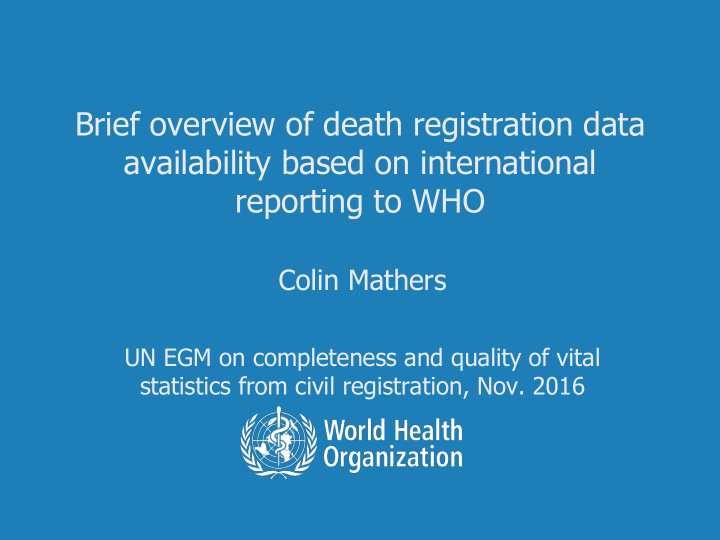



Brief overview of death registration data availability based on international reporting to WHO Colin Mathers UN EGM on completeness and quality of vital statistics from civil registration, Nov. 2016
http://www.who.int/healthinfo/mortality_data/en/ Information, Evidence and Research
Mechanism for cause-of-death data collection HQ Emro Amro Euro Requests all Follows up countries of Afr, Requests all Requests with each Emr, Sear, Wpr Amr eastern country and some countries European following HQ countries of countries call Europe Thru' WR Joint Requested request with directly from CAREC Eurostat countries – Feb 2016 Information, Evidence and Research
Mechanism for cause-of-death data standardization and validation HQ Emro Amro Euro Requests all Follows up countries of Requests all Requests with each Afr, Emr, Sear, Amr eastern country Wpr and some countries European following HQ countries of countries call Europe Standardizes, validates and All data received are sent to HQ for standardization and shares the data validation – Regional offices liaise with countries to with HQ resolve inconsistencies Information, Evidence and Research
Per cent of countries reporting, by region
Data comparability issues Preference: data by year of occurrence, but unclear when data are received • Not always clear if data are for residents or citizens or include non-residents • Total deaths from CoD data are in most cases subsets of the total deaths from • population registers. E.g. Israel, Iran Very few countries align the total number of deaths in their CoD data set with • the number from population registers Some countries provide population data, but not usually consistent updated • time-series, or compatible with UN population estimates Because of confidentiality issues, some countries are unwilling to share the • data by 5-year age-group Reporting age format mostly 5 year age groups to 95+ or 85+ but some • variation in final age group (65, 75) and some 10 year age group data Information, Evidence and Research
Country data issues Cyprus : data for government-controlled areas • Palestine : data for West Bank only • Georgia : exclude Abkhazia and South Osetia • Moldova : exclude Transnitria and Bender • Russian Fed : exclude Chechenya (1993-2003) • but include Chechenya as from 2004 Serbia : exclude Kosovo-Metohija province • Ukraine : exclude non-government controlled • areas as from 2014
Information, Evidence and Research
Data availability for all-cause mortality Number of WHO a Percentage of Available recent Member States global deaths in data b 2015 (since 2005) Methods Death-registration data 59 28 Observed death rates with completeness >=90% Incomplete death- 38 25 Adjusted death rates registration data Other population- 21 25 Estimated death rates representative data on and model life table age-specific mortality systems Data on child (under 5 48 12 Estimated death rates years) and adult (15 – 59 and model life table years) mortality only systems Data on child mortality 59 10 Model life table systems only No recent data 1 <1 Projected from data for years before 2005 a With population above 90 000 in 2015. b Total deaths that occur in the countries with data, not total registered deaths
Improved coverage in countries South Africa : ~ 50% in 1990s ~ 90% in 2014 Turkey : ~ 50% in 2007 ~ 85% in 2013 Iran: ~ 40% in 2001 ~ 70% in 2014 China: ~ 9% in 2000 ? >50% in 2015
SDG Indicator 17.19.2 Proportion of countries that have achieved 80% death registration
Momentum for Improvement in VR systems Ministerial commitments – Africa, Asia, • Pacific, Latin Americas, Middle East Global Commitments – SDGs, G7 Health • Ministers, Global Health – • WHO (Global Strategy for Women’s and Children’s Health, CoIA, • African Technical Strategy for Improving Mortality Statistics) Canada and the World Bank (Global Financing Facility) • Health Partnerships for Countries – WHO working • with Global Fund, UNICEF, CDC, Bloomberg, Regional Partnerships Information, Evidence and Research
Ministerial Statement: African Ministers responsible for Civil Registration, Republic of Côte d’Ivoire, 12 and 13 February 2015 …. Recognizing that the Ebola epidemic has shown that the need for death registration and real time cause-of-death information is no longer optional but critical; ….Realizing the centrality of civil registration based vital statistics in providing data to inform health…. …. Appreciating the increased and continuing involvement of the African Ministers of Health in improving registration of births and deaths, including the collection of information on cause-of-death; ….Underscoring the important role of the health sector in the delivery of civil registration services to ensure a coordinated and integrated approach in addressing the challenges of improving CRVS systems in Africa; ….Call upon WHO, in collaboration with Pan African Organizations and other partners, to intensify their efforts in developing real time death registration and causes of death information systems at country level. Information, Evidence and Research
Recommend
More recommend